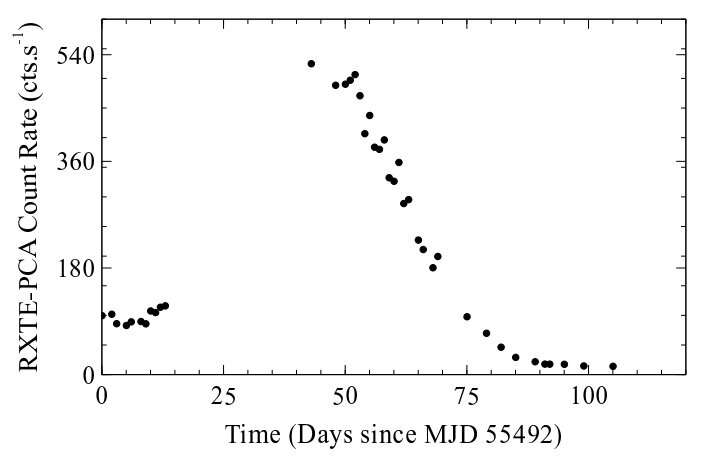November 18, 2019 report
Study sheds more light on the nature of the transient X-ray pulsar MAXI J1409-619

Turkish astronomers have analyzed the observational data of the transient X-ray pulsar MAXI J1409-619 to probe the properties of this source. The study provided a comprehensive timing and X-ray spectral analysis of the pulsar, shedding more light on the nature of this object. Results of the research were published November 7 on arXiv.org.
X-ray pulsars (also known as accretion-powered pulsars) are sources displaying strict periodic variations in X-ray intensity, consisting of a magnetized neutron star in orbit with a normal stellar companion. In these binary systems, the X-ray emission is powered by the release of gravitational potential energy as material is accreted from a massive companion. X-ray pulsars are among the most luminous objects in the X-ray sky.
Discovered on October 17, 2010 as part of the Monitor of All-sky X-ray Image (MAXI) experiment, MAXI J1409-619 is a transient pulsar in a high-mass X-ray binary (HMXB) system. On November 30, 2010, it underwent an outburst, becoming about seven times brighter when compared to the initial observations that revealed its 503-second periodicity with 42 percent sinusoidal peak-to-through modulation.
After its identification, MAXI J1409-619 was observed by the Neil Gehrels Swift Observatory and the Rossi X-ray Timing Explorer (RXTE). A group of astronomers led by Çağatay Kerem Dönmez of the Middle East Technical University in Ankara, Turkey, reports that the results of these observations unveiled more details about the nature of this pulsar.
The study found that the system most likely has a circular orbit with an orbital period of approximately 14.9 days and that the orbital inclination angle should be very small.
According to the paper, the results point to a temporary accretion disc forming during the outburst of MAXI J1409-619. Based on the standard accretion disc theory, the researchers estimated that the inner disc radius is about 4,800 kilometers. The surface dipole magnetic field strength was calculated to be around 290 billion Gauss.
Moreover, the astronomers detected several quasi-periodic oscillations (QPOs) in MAXI J1409-619. It is believed that QPOs occur when X-rays are emitted near the inner edge of an accretion disk in which gas swirls onto a compact object like a neutron star or a black hole.
"We also discover several quasi-periodic oscillations with their harmonics, whose centroid frequencies decrease as the source flux decays," the paper reads.
The finding makes MAXI J1409-619 one of only two accreting X-ray pulsars known to exhibit QPO harmonics.
Spectral analysis of MAXI J1409-619 also revealed that its spectrum was found to be softer when the luminosity is lower than about 5.0 undecillion erg/s.
"Photon index doesn't vary significantly with RXTE-PCA flux except for the lowest X-ray fluxes (< 2 × 10−10 ergs s−1 cm−2 corresponding to an upper limit of X-ray luminosity of about 5 × 1036 ergs s−1) for which power law index is significantly higher indicating a softer spectrum," the authors of the paper concluded.
More information: Comprehensive Analysis of the Transient X-ray Pulsar MAXI J1409-619, arXiv:1911.02871 [astro-ph.HE] arxiv.org/abs/1911.02871
© 2019 Science X Network





















